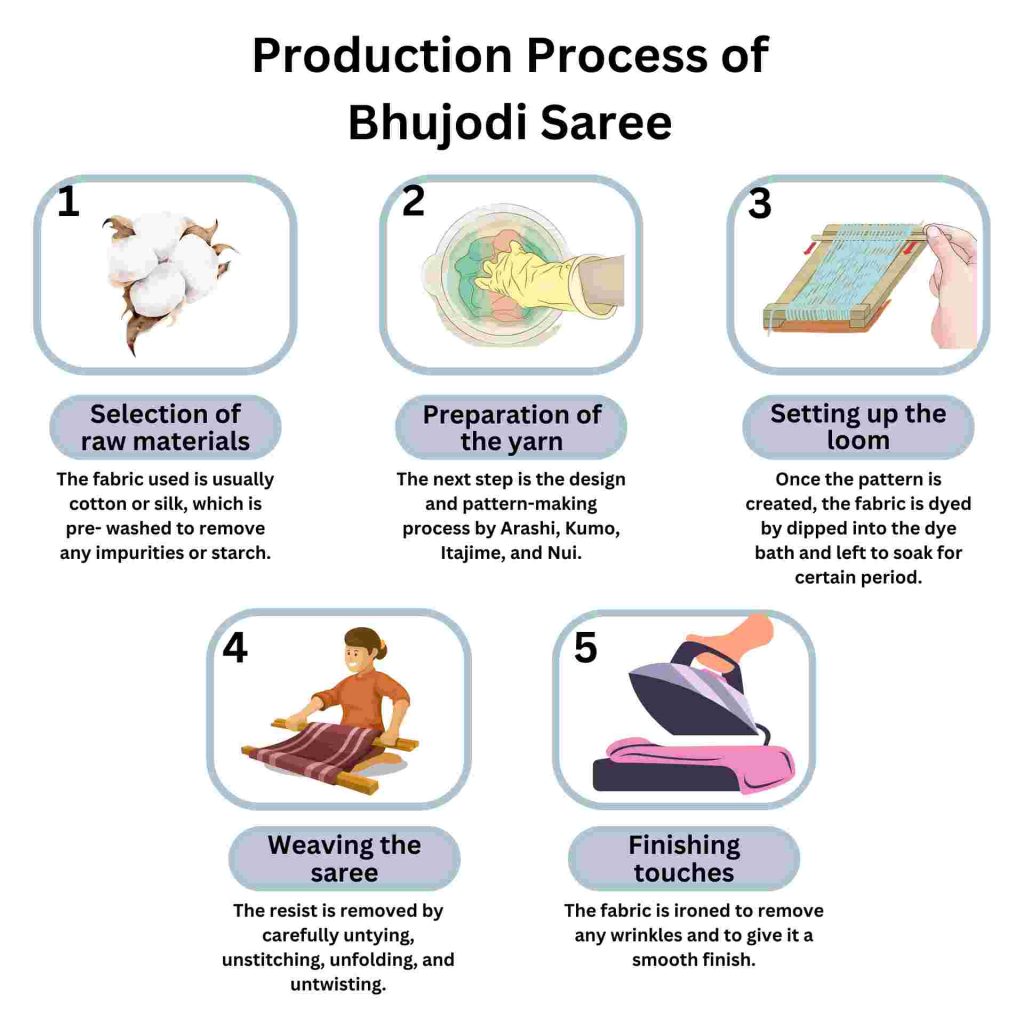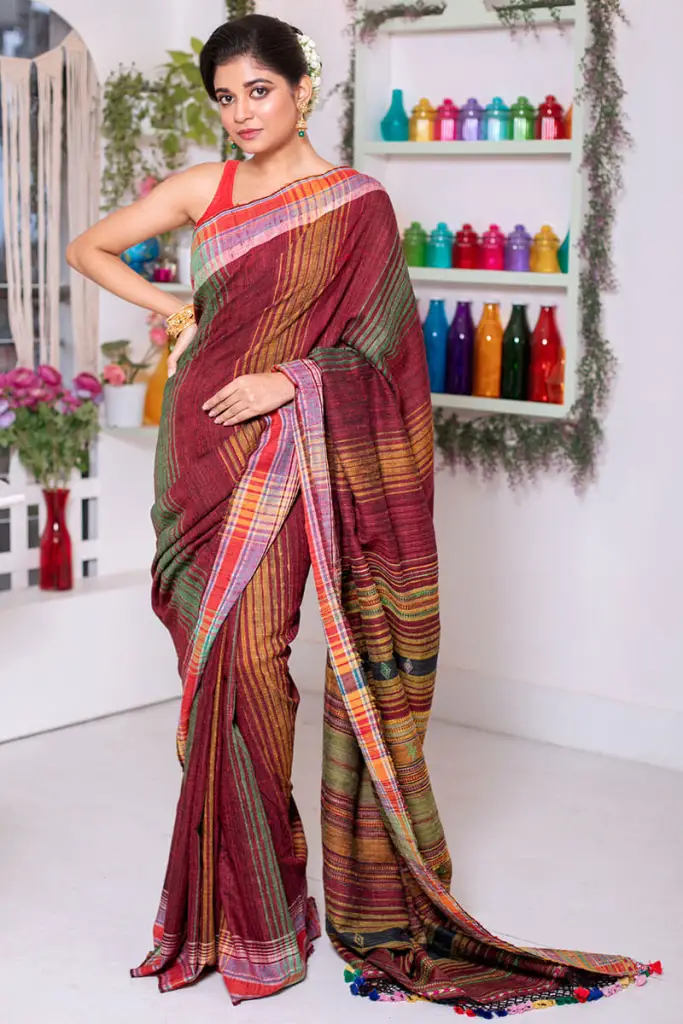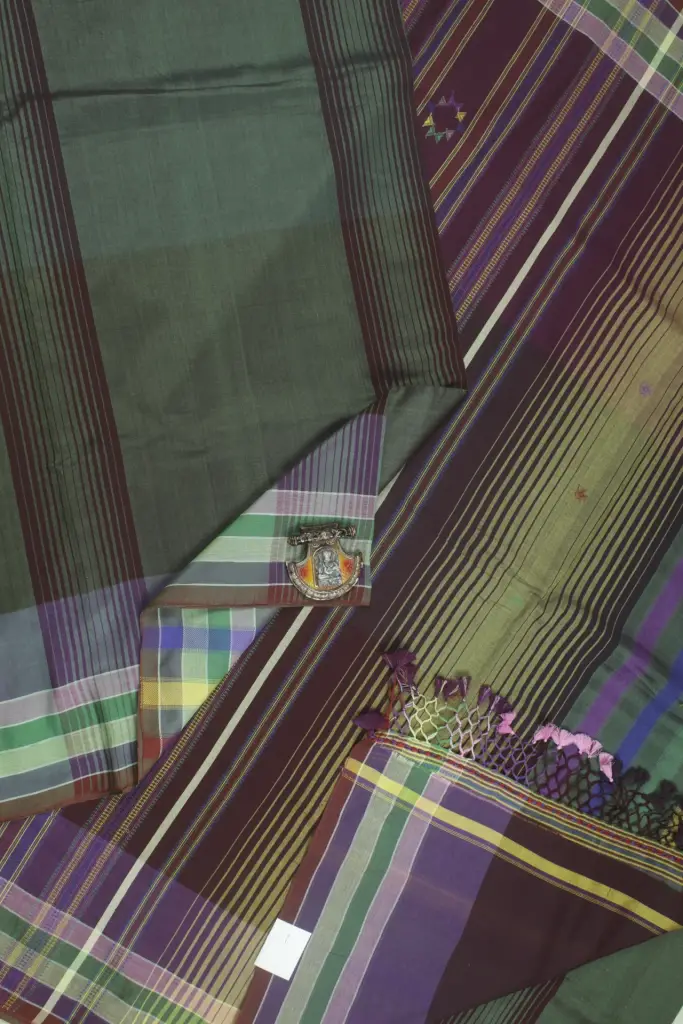Each region in India has its unique style of sarees, and the Bhujodi saree from Gujarat is one such exquisite piece of art.
Bhujodi sarees are known for their intricate designs, vibrant colors, and exceptional weaving techniques.
In this article, we will take a closer look at the Bhujodi saree and explore its rich history, unique features, and the artisans who keep this craft alive.
BHUJODI SAREE ORIGIN AND HISTORY
Bhujodi sarees have a fascinating history that dates back hundreds of years.
The town of Bhujodi, located in the Kutch district of Gujarat, is renowned for its handloom weavers who have been weaving these sarees for generations.
The art of weaving Bhujodi sarees is believed to have been passed down from the ancestors of the weavers, who migrated from Sindh in Pakistan during the partition of India in 1947.
These weavers were skilled in weaving shawls and blankets using wool from the local sheep, and over time, they began experimenting with new designs and techniques to create sarees.
The weavers of Bhujodi sarees have been preserving this traditional art form for centuries, and their work has been recognized globally.
BHUJODI SAREE WEAVERS
The weavers of Bhujodi sarees are the backbone of this craft. They work tirelessly to preserve this traditional art form and ensure that it continues to thrive.
Many of these weavers come from families who have been weaving Bhujodi sarees for generations, and they take immense pride in their work.
Weaving a Bhujodi saree is a time-consuming process that requires skill, patience, and precision.
The weavers work on a single saree for several days, carefully weaving each thread to create intricate designs.
The weavers use their creativity and imagination to come up with unique designs, and each saree is a masterpiece in itself.
However, despite their dedication and hard work, the weavers often face several challenges.
The lack of support from the government and the rise of machine-made sarees have made it difficult for these artisans to sustain their livelihoods.
THE PROCESS FOLLOWED BY BHUJODI SAREE MANUFACTURERS
The production process of Bhujodi sarees involves the following steps:

- Selection of raw materials: The weavers of Bhujodi sarees use the finest quality cotton and wool for weaving. They carefully select the raw materials to ensure that the saree is of the highest quality.
- Preparation of the yarn: The raw material is then spun into yarn, which is then dyed using natural dyes. The yarn is washed and sun-dried to ensure that it is free from impurities.
- Setting up the loom: The warp threads are set up on the loom, which is a wooden frame that holds the threads in place. The weft threads are then woven into the warp threads to create the fabric.
- Weaving the saree: The weavers then carefully weave the saree using intricate patterns and designs. They use the extra weft technique to create unique motifs and textures.
- Finishing touches: Once the saree is woven, the weavers add the finishing touches, such as the borders and pallu. The saree is then washed and ironed to give it a polished look.
CONTEMPORARY DESIGNS IN BHUJODI SAREE
While Bhujodi sarees have a rich history, they have also evolved with time. Today, designers are experimenting with contemporary designs and patterns to appeal to a wider audience.
Some of the contemporary designs in Bhujodi sarees include geometric patterns, abstract designs, and fusion designs that combine traditional motifs with modern elements.
Contemporary designs have brought a fresh perspective to Bhujodi sarees, making them more accessible to a younger audience.
These designs incorporate modern elements while keeping the traditional essence of the saree intact.
MAINTENANCE OF BHUJODI SAREE
Bhujodi sarees should be dry cleaned only to avoid damaging the delicate fabric. When storing the saree, make sure that it is wrapped in a clean cotton cloth.
Avoid storing it in direct sunlight or damp areas. Use a low-heat iron to iron the saree. Avoid ironing the borders and pallu to prevent damaging the intricate designs.
CULTURAL SIGNIFICANCE OF BHUJODI SAREE
Bhujodi sarees are an important part of the cultural heritage of Gujarat, India. They have a rich history and are valued for their intricate designs, texture, and handwoven craftsmanship.
They are an essential part of the traditional attire for women in Gujarat, often worn on special occasions such as weddings, festivals, and other religious ceremonies.
This saree represents the cultural identity of the Kutch region of Gujarat. They are an expression of the unique art and craft traditions of the region.
And finally, the production of Bhujodi sarees provides employment opportunities for local weavers and artisans. It also contributes to the local economy by promoting tourism and trade.
DIFFERENT TYPES OF BHUJODI SAREES
- Cotton Bhujodi sarees: These sarees are made from pure cotton yarn and are known for their soft texture and comfort. They are often woven with simple designs and patterns.

- Silk Bhujodi sarees: Silk Bhujodi sarees are made from pure silk yarn and are known for their lustrous texture and rich designs.

- Kala cotton Bhujodi sarees: Kala cotton Bhujodi sarees are made from a type of cotton that is native to Kutch. They are known for their durability and sustainability as they are grown using organic farming methods.

UNIQUE FEATURES OF BHUJODI SAREE
Bhujodi sarees are handwoven using the finest quality cotton and wool. The weavers use a traditional pit loom, which is a wooden frame that is used to hold the warp threads in place.
One of the unique features of Bhujodi sarees is the use of the extra weft technique, where the weavers add extra threads to create intricate motifs and textures.
This technique requires a lot of skill and patience, and the weavers spend several hours working on each saree to ensure that the design is perfect.
Bhujodi sarees are available in a range of colors, from bright pinks and oranges to earthy browns and greens.
The weavers use natural dyes to achieve these colors, making Bhujodi sarees eco-friendly and sustainable.
PREFERENCE OF BHUJODI SAREE FOR WEDDINGS AND OTHER OCCASIONS
Bhujodi sarees are versatile and can be worn for various occasions.
For casual outings such as lunch date or a day out with friends, cotton bhujodi saree with minimal designs and light colors is preferred.
For formal events such as weddings, receptions, and religious ceremonies, Silk Bhujodi sarees with intricate designs and rich colors are ideal for formal events and lastly, for festive occasions such as Diwali, Bhujodi sarees with bright colors and traditional designs are recommended.
BHUJODI SAREE BLOUSE DESIGNS
- Simple blouse

- Embroidered blouse

- Jacket blouse

BHUJODI SAREE PRICE
Generally, the price of a Bhujodi saree starts at around INR 5,000 and can go up to INR 50,000 or more for more intricate designs.
The price range of Bhujodi sarees can vary significantly, depending on various factors such as the intricacy of the design, the quality of the fabric, and the reputation of the weaver. Here are some approximate price ranges of Bhujodi sarees:
- Cotton Bhujodi sarees: Prices range from around INR 2,000 to INR 6,000.
- Silk Bhujodi sarees: Prices range from around INR 4,000 to INR 15,000.
- Gharchola Bhujodi sarees: Prices range from around INR 8,000 to INR 25,000.
- Kala cotton Bhujodi sarees: Prices range from around INR 3,000 to INR 10,000.
STORES SELLING BHUJODI SAREE ONLINE
LATEST BHUJODI SAREE TRENDS
Bhujodi sarees have gained popularity in recent years due to their unique texture, intricate designs, and handwoven craftsmanship.
They have become a popular choice among women who appreciate traditional textiles and want to wear clothing that reflects the cultural heritage of Gujarat.
In the present-day, Bhujodi sarees are still being produced by skilled weavers in Kutch, Gujarat. The demand for these sarees has grown significantly in recent years, and they are now being sold across India and around the world.
However, like many other traditional textiles, Bhujodi sarees are facing challenges in the modern era.
Factors such as the availability of cheaper machine-made alternatives, the lack of government support for the handloom sector, and changing fashion trends are posing a threat to the future of handwoven textiles such as Bhujodi sarees.
To address these challenges, efforts are being made to promote the handloom sector, improve the livelihoods of weavers, and raise awareness about the cultural importance of traditional textiles.







